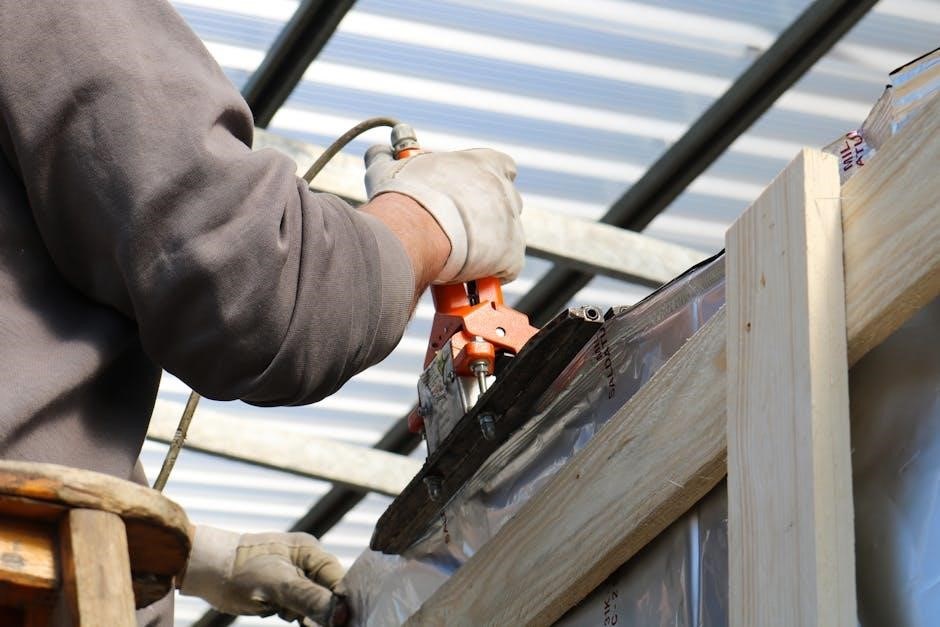Wood frame construction is a popular building method worldwide, offering efficiency, sustainability, and cost-effectiveness. It involves assembling structural elements like walls, floors, and roofs using wood framing techniques. This method is widely used in residential and light commercial buildings due to its adaptability and ease of construction. The Wood Frame Construction Manual provides standardized guidelines for designing and building safe, durable wood-framed structures, ensuring compliance with local building codes and engineering principles.
Key Components of the Wood Frame Construction Manual
The manual includes engineered and prescriptive design requirements, load calculations, and guidelines for structural elements like walls, floors, and roofs, ensuring safe and code-compliant wood-framed buildings.
2.1. Engineered Design Requirements
Engineered design requirements in the Wood Frame Construction Manual focus on precise calculations and analysis to ensure structural integrity. These requirements are based on accepted engineering practices and standards, such as ASCE 7-16 for wind and seismic loads, and the National Design Specification (NDS) for wood construction. Engineers must consider factors like material strength, connection details, and load paths to design components such as beams, columns, and shear walls. The manual also provides formulas and tables to aid in calculating member sizes, fastener capacities, and deflection limits. Compliance with these engineered requirements ensures that wood-framed structures meet safety and performance standards, particularly in high-wind, snow, and seismic areas. This section emphasizes the importance of professional engineering expertise to tailor designs to specific project needs and local building codes.

2.2. Prescriptive Design Requirements
Prescriptive design requirements in the Wood Frame Construction Manual provide standardized, code-compliant guidelines for constructing wood-framed buildings without the need for customized engineering. These requirements are based on tested practices and are suitable for typical building conditions. They include specifications for lumber sizes, fastening methods, framing spacing, and other structural details to ensure safety and durability. The prescriptive approach simplifies the construction process, making it cost-effective for standard projects like single-family homes. These requirements are aligned with local building codes, such as the International Building Code (IBC) and International Residential Code (IRC), ensuring compliance. While prescriptive designs are efficient for common applications, they may not address unique conditions like extreme loads or complex geometries, which require engineered solutions. This approach is ideal for builders seeking straightforward, reliable construction methods.

Structural Elements in Wood Frame Construction
Wood frame construction involves wall, floor, and roof systems, utilizing sawn lumber, engineered wood, and connections. These elements provide structural support and design flexibility while meeting building codes.
3.1. Wall Systems
Wall systems in wood frame construction are designed to provide structural support and resist loads. They typically consist of studs, top and bottom plates, and sheathing materials like plywood or oriented strand board (OSB). These components work together to ensure lateral and vertical load resistance. Exterior walls often include insulation and weather-resistant barriers for energy efficiency and durability. The Wood Frame Construction Manual outlines prescriptive and engineered design methods for wall assemblies, ensuring compliance with building codes and standards. Proper construction techniques are emphasized to maintain structural integrity and prevent issues like racking or shear failure. Wall systems are customizable to accommodate various architectural designs while meeting performance requirements for safety and sustainability.
3.2. Floor Systems
Floor systems in wood frame construction are essential for supporting building loads and ensuring structural stability. They typically consist of joists, beams, and subflooring materials. Joists are horizontal structural members spaced at regular intervals, while beams provide additional support for larger spans. Subflooring, such as plywood or oriented strand board (OSB), is installed over the joists to create a smooth, durable surface for finished flooring. The Wood Frame Construction Manual provides design and construction guidelines for floor systems, including prescriptive and engineered methods. Load-bearing capacities, deflection limits, and connection details are critical considerations. Materials like I-joists and structural glued-laminated timber beams offer enhanced strength and stability. Proper installation ensures even weight distribution and minimizes issues like squeaking or sagging. The manual also addresses fire-resistance ratings and sound transmission requirements, ensuring floors meet both functional and safety standards.
3.3; Roof Systems
Road systems in wood frame construction are designed to support roof loads while maintaining structural integrity. They typically include rafters, trusses, and roof sheathing. Rafters are sloped members spanning from the wall to the ridge, while trusses provide pre-engineered solutions for complex roof shapes. Roof sheathing, such as plywood or oriented strand board (OSB), is installed over rafters or trusses to create a nailing surface for roofing materials. The Wood Frame Construction Manual outlines prescriptive and engineered design methods for roof systems, ensuring they can withstand snow, wind, and other environmental loads. Connections between rafters, trusses, and walls are critical for load transfer and stability. Properly designed roof systems also consider factors like deflection, drainage, and thermal performance. Adhering to the manual’s guidelines ensures safe, durable, and code-compliant roof construction, suitable for various residential and light commercial applications.

Load Considerations
Load considerations are crucial for wood frame construction, ensuring structures withstand wind, snow, and seismic forces. The manual references ASCE 7-16 for wind loads and National Building Code of Canada for seismic requirements.
4.1. Wind Loads
Wind loads are a critical consideration in wood frame construction, as they can exert significant forces on buildings. The 2018 Wood Frame Construction Manual references ASCE 7-16 for wind load calculations, ensuring structures are designed to withstand various wind conditions. Prescriptive design provisions are provided for high-wind areas, outlining requirements for wall systems, roof systems, and connections. These provisions ensure that wood-framed buildings maintain structural integrity under wind pressure. The manual also addresses fastener requirements and spacing to resist wind-induced forces effectively. By adhering to these guidelines, builders can construct safe and durable wood-framed structures that perform well in windy environments. Proper design and construction practices, as outlined in the manual, are essential to mitigate the risks associated with wind loads and ensure compliance with building codes.
4.2. Snow Loads

Snow loads are a significant design consideration in wood frame construction, particularly in regions with heavy snowfall. The Wood Frame Construction Manual provides detailed guidelines for calculating and addressing snow loads to ensure structural integrity. These provisions are based on ASCE 7-16 and include specific design requirements for roof systems, wall systems, and foundations. The manual emphasizes the importance of proper framing and connection details to resist snow-induced stresses. It also covers factors such as roof pitch, insulation, and drainage, which influence snow accumulation and load distribution. Builders must adhere to these guidelines to prevent structural failure due to excessive snow weight. Additionally, the manual addresses regional variations in snow loads, ensuring designs are tailored to local conditions. Properly designed wood-framed structures can safely withstand snow loads when constructed according to the manual’s specifications.
4.3. Seismic Loads
Seismic loads pose unique challenges in wood frame construction, requiring specialized design and detailing to ensure structural resilience during earthquakes. The Wood Frame Construction Manual provides comprehensive guidelines for designing wood-framed buildings to resist seismic forces. These provisions are aligned with the latest engineering standards, including ASCE 7-16, and address factors such as ground motion, building occupancy, and site-specific conditions. The manual emphasizes the importance of proper connection details, such as hold-downs and shear transfer mechanisms, to maintain structural integrity under seismic stress. It also includes prescriptive design methods for various structural elements, ensuring compliance with local building codes. Wood framing’s inherent flexibility and energy dissipation capabilities make it a viable option for seismic-resistant construction when designed according to these guidelines. Builders must carefully follow the manual’s recommendations to ensure safety and performance in seismically active regions.
